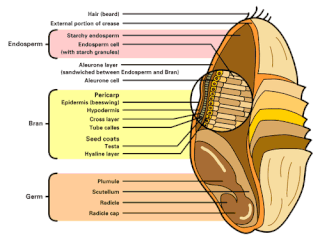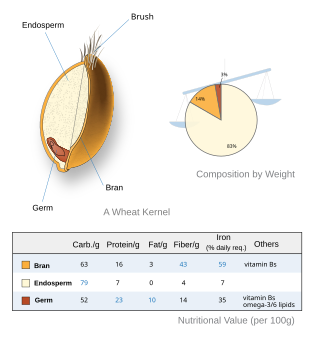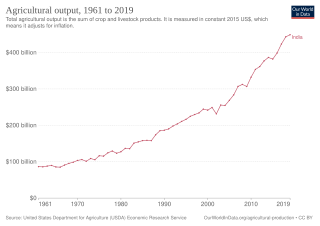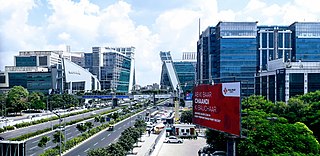
A cereal is a grass cultivated for its edible grain. Cereals are the world's largest crops, and are therefore staple foods. They include rice, wheat, rye, oats, barley, millet, and maize. Edible grains from other plant families, such as buckwheat and quinoa are pseudocereals. Most cereals are annuals, producing one crop from each planting, though rice is sometimes grown as a perennial. Winter varieties are hardy enough to be planted in the autumn, becoming dormant in the winter, and harvested in spring or early summer; spring varieties are planted in spring and harvested in late summer. The term cereal is derived from the name of the Roman goddess of grain crops and fertility, Ceres.

Flour is a powder made by grinding raw grains, roots, beans, nuts, or seeds. Flours are used to make many different foods. Cereal flour, particularly wheat flour, is the main ingredient of bread, which is a staple food for many cultures. Corn flour has been important in Mesoamerican cuisine since ancient times and remains a staple in the Americas. Rye flour is a constituent of bread in both Central Europe and Northern Europe.

General Mills, Inc., is an American multinational manufacturer and marketer of branded ultraprocessed consumer foods sold through retail stores. Founded on the banks of the Mississippi River at Saint Anthony Falls in Minneapolis, the company originally gained fame for being a large flour miller. Today, the company markets many well-known North American brands, including Gold Medal flour, Annie's Homegrown, Lärabar, Cascadian Farm, Betty Crocker, Yoplait, Nature Valley, Totino's, Pillsbury, Old El Paso, Häagen-Dazs, as well as breakfast cereals under the General Mills name, including Cheerios, Wheaties, Chex, Lucky Charms, Trix, Cocoa Puffs and Count Chocula and the other monster cereals.

Punjabi cuisine is a culinary style originating in the Punjab, a region in the northern part of South Asia, which is now divided in an Indian part to the east and a Pakistani part to the west. This cuisine has a rich tradition of many distinct and local ways of cooking.

The germ of a cereal grain is the part that develops into a plant; it is the seed embryo. Along with bran, germ is often a by-product of the milling that produces refined grain products. Cereal grains and their components, such as wheat germ oil, rice bran oil, and maize bran, may be used as a source from which vegetable oil is extracted, or used directly as a food ingredient. The germ is retained as an integral part of whole-grain foods. Non-whole grain methods of milling are intended to isolate the endosperm, which is ground into flour, with removal of both the husk (bran) and the germ. Removal of bran is aimed at producing a flour with a white rather than a brown color, and eliminating fiber, which reduces nutrition. The germ is rich in polyunsaturated fats and so germ removal improves the storage qualities of flour.

A whole grain is a grain of any cereal and pseudocereal that contains the endosperm, germ, and bran, in contrast to refined grains, which retain only the endosperm.

Bahawalpur District is a district of Punjab, Pakistan, with capital the city of Bahawalpur. According to the 1998 Census it had a population of 2,433,091, of which 27.01% were urban. Bahawalpur district covers 24,830 km2. Approximately two-thirds of the district (16,000 km2) is covered by the Cholistan Desert, which extends into the Thar Desert of India. The district is a major producer of cotton.

Sri Ganganagar is the northernmost city of the Indian state of Rajasthan, near the international border of India and Pakistan. It is the administrative headquarters of Sri Ganganagar district. It is named after Maharaja Shri Ganga Singh Bahadur, Maharaja of Bikaner. The city is also known as the "Food Basket of Rajasthan".
TheNational Milling Company of Guyana(NAMILCO) is the largest and oldest operating commercial flour mill in the Co-operative Republic of Guyana, having celebrated its 50th anniversary of operations in 2019. The company was established as a subsidiary of the Seaboard Corporation, an international agribusiness conglomerate based in the United States, on 17 May 1969. The mill produces wheat-based products for both the Guyanese consumer and commercial markets alongside local foodstuffs primarily consumed by the Guyanese Indian population, a substantial ethnic group in the country. The factory is located adjacent to East Bank Public Road, Agricola, Georgetown. The National Milling Company of Guyana is headed by Managing Director Mr Roopnarine 'Bert' Sukhai.

The history of agriculture in India dates back to the Neolithic period. India ranks second worldwide in farm outputs. As per the Indian economic survey 2020 -21, agriculture employed more than 50% of the Indian workforce and contributed 20.2% to the country's GDP.
Maida, maida flour, or maida mavu is a type of wheat flour originated from the Indian subcontinent. It is a super-refined wheat flour used in Indian cuisine to make pastries and other bakery items like breads and biscuits. Some maida may have tapioca starch added.

Syed Fakhar Imam is a Pakistani politician and statesman who has held several positions in the Government of Pakistan including, the Minister for Parliamentary Affairs, the Minister for Law and the Minister for Education, and served as Federal Minister for National Food Security and Research, from April 2020 to April 2022. He was preceded by Malik Meraj Khalid, serving as the 11th speaker of the National Assembly of Pakistan from 1985 to 1986. Imam has previously worked as the Chairman of Pakistan's Parliamentary Special Committee on Kashmir.
The economy of Punjab is the 16th largest state economy in India with ₹5.41 lakh crore (US$68 billion) (FY2020-21) in gross domestic product and a per capita GDP of US$2360(180,000) ranking 19th amongst Indian states.

The Green Revolution was a period that began in the 1960s during which agriculture in India was converted into a modern industrial system by the adoption of technology, such as the use of high yielding variety (HYV) seeds, mechanised farm tools, irrigation facilities, pesticides, and fertilizers. Mainly led by agricultural scientist M. S. Swaminathan in India, this period was part of the larger Green Revolution endeavor initiated by Norman Borlaug, which leveraged agricultural research and technology to increase agricultural productivity in the developing world. Varieties or strains of crops can be selected by breeding for various useful characteristics such as disease resistance, response to fertilizers, product quality and high yields.

Arrowhead Mills is a brand of organic baking mixes, grains, and, cereals.

GSDP of Haryana state is estimated to be US$140 billion in 2023-2034 which had grown at 12.96% CAGR between 2012–17, boosted by the fact that this state on DMIC in NCR contributes 7% of India's agricultural exports and 60% of India's Basmati rice export, with 7 operational SEZs and additional 23 formally approved SEZs. Haryana also produces India's 67% of passenger cars, 60% of motorcycles, 50% of tractors and 50% of the refrigerators, which places Haryana on 14th place on the list of Indian states and union territories by GDP behind only much bigger states that are significantly larger in both area and population.

The Public Distribution System (PDS) is an Indian food security system that was established by the Government of India under the Ministry of Consumer Affairs, Food and Public Distribution to distribute food and non-food items to India's poor at subsidised rates. Major commodities distributed include staple food grains, such as wheat, rice, sugar and essential fuels like kerosene, through a network of fair price shops established in several states across the country. Food Corporation of India, a government-owned corporation, procures and maintains the PDS.

The National Food Security Act 2013, also known as Right to Food Act, is an Indian Act of Parliament which aims to provide subsidized food grains to approximately two thirds of the country's 1.4 billion people. It was signed into law on 12 September 2013, retroactive to 5 July 2013.

A staple food, food staple, or simply staple, is a food that is eaten often and in such quantities that it constitutes a dominant portion of a standard diet for an individual or a population group, supplying a large fraction of energy needs and generally forming a significant proportion of the intake of other nutrients as well. For humans, a staple food of a specific society may be eaten as often as every day or every meal, and most people live on a diet based on just a small variety of food staples. Specific staples vary from place to place, but typically are inexpensive or readily available foods that supply one or more of the macronutrients and micronutrients needed for survival and health: carbohydrates, proteins, fats, minerals, and vitamins. Typical examples include grains, seeds, nuts and root vegetables. Among them, cereals, legumes and tubers account for about 90% of the world's food calorie intake.

Dilbagh Singh Athwal was an Indian-American geneticist, plant breeder and agriculturist, known to have conducted pioneering research in plant breeding. He was a professor and the Head of the Department of Plant Breeding at Punjab Agricultural University and an associate of Norman Borlaug, a renowned biologist and Nobel Laureate, with whom he has collaborated for the introduction of high-yielding dwarf varieties of wheat.

















